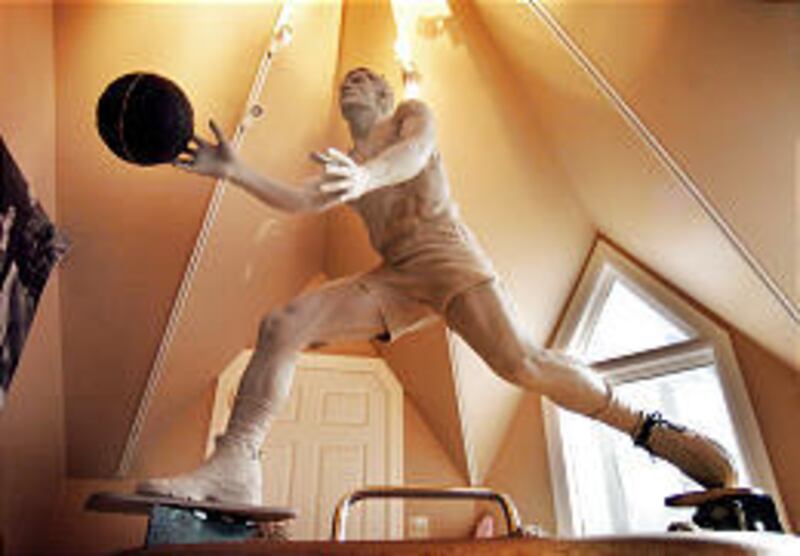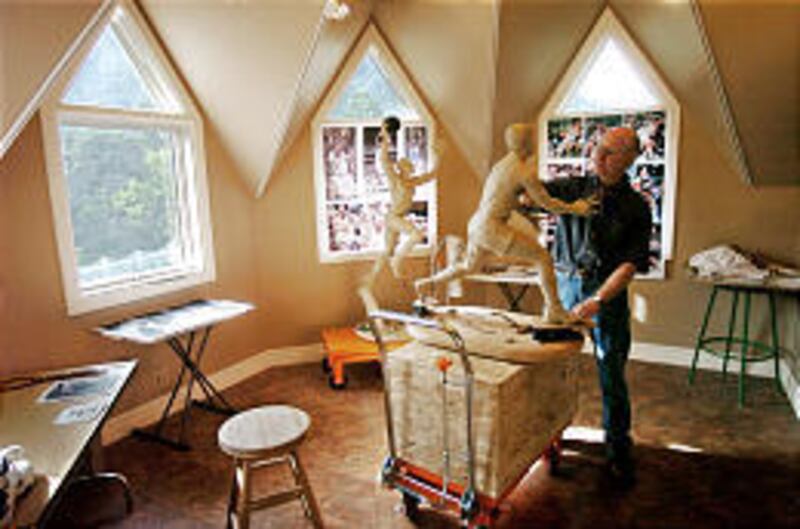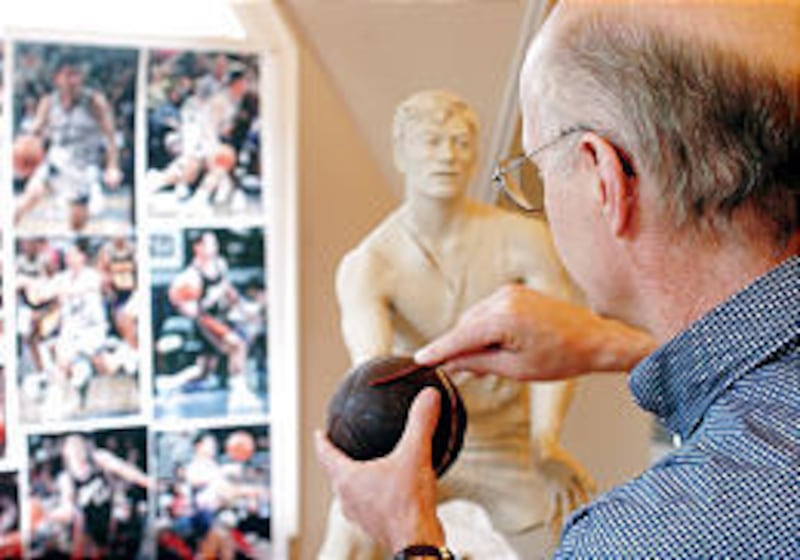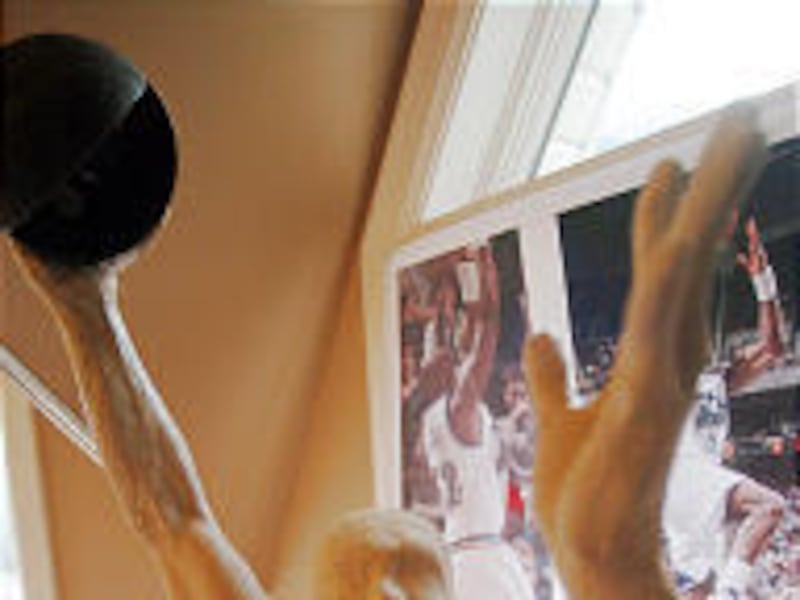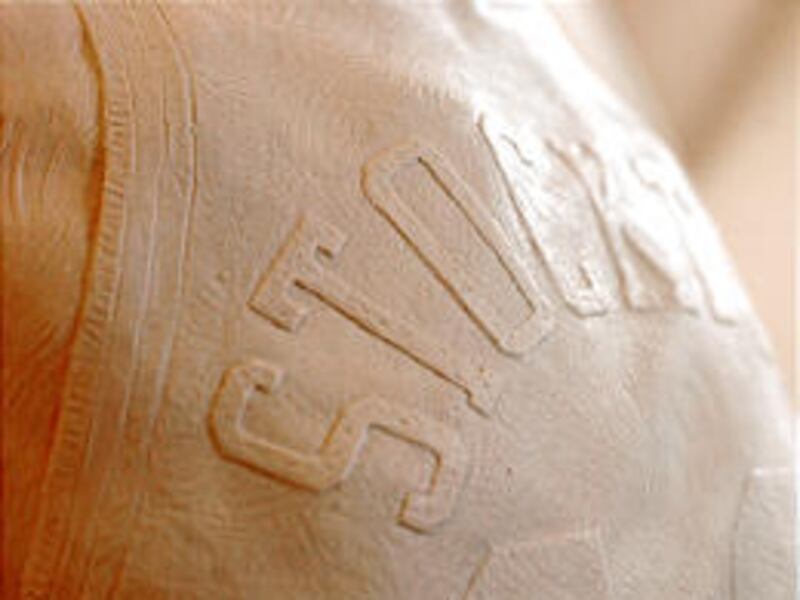It was just the kind of scene that John Stockton used to loathe. During a visit to Salt Lake City last November, two photographers followed him around a gym — one with a video camera, one with a still camera — taking his picture for a couple of hours under the direction of sculptor Brian Challis and an assistant.
They took photos from every possible angle, moving slowly around his head. There was one photo looking up at the underside of his chin and nostrils and another looking down on the top of his head — all deemed necessary because, as a sculptor, Challis works in 3-D.
"He was really good," says Challis. "I expected him to be anxious, to want to get this over with. He was funny. He joked quite a bit. He was very relaxed. He said take whatever time you need."
Eight months later, the statue of the Jazz's great point guard — the original clay model of the one that
will eventually stand outside the Delta Center in bronze — is taking shape with a certain degree of secrecy. The Stockton statue is posed as fans remember him, passing the ball. What else?
In a tiny studio in an upstairs room of a large house in Sandy, the statue has almost come to life under the hands of Challis, a man who used to make stairways for a living and was a neighbor to Jazz owner Larry Miller.
For six months Challis has labored over every detail of the work right down to the way Stockton's left hand flexed into a Vulcan sign whenever he released a pass. Sometime next winter — maybe February or March — the statue will be unveiled for the public. It will stand on the southeast corner of the Delta Center (there are too many trees to place it on the northeast plaza), some 13 feet tall from the ground to the top of his head, counting the 5-foot base on which it will stand.
Eventually, an 18-foot statue of Karl Malone will be placed alongside it, but only after he has retired from play. Challis already has roughed out most of the Malone figure (going up for a hammer dunk).
"We'd like him to be retired first," says Challis. "Larry wants each of them to have his moment in the sun."
Opportunity of a lifetime
Challis went to painstaking efforts for accuracy and detail on the Stockton statue, which is why he met Stockton in the gym and ordered hundreds of photos to be taken. He tried to set up a similar meeting with Malone, but his request was ignored.
Once he got Stockton in the gym, he asked him to pose, "but he didn't do a good job of posing. It didn't look natural. He's not used to holding a position." So he had him move and play and even asked Stockton to direct his passes to him.
"Are you sure you want that?" Stockton asked, knowing his passes were not the gentler playground variety.
In the end, Challis looked through thousands of photos — those from the photo session and from Stockton's playing days — and collected about 100 of them. From there, he chose 10 photos to place on a large poster, which he taped to a window in his studio, although he says he still referred to other photos frequently, including one life size.
For Challis, it was the artistic opportunity of a lifetime.
"It's a great project for a sculptor," he explains. "First, because of athletes' builds — they have great muscular definition. It's also a great opportunity for an artist to do a work of a prominent figure and to make something so it can be seen, and this is something that will be seen a lot."
Every Jazz game, he'll have an audience of 19,000 to view his work. How many galleries get that kind of attention?
Attention to detail
Challis went to painstaking efforts for accuracy and detail. He studied anatomy books. He even read a book about wrinkles in clothing. He obtained uniforms (and shoes) worn by Stockton and Malone and frequently tugged on and contorted them in various ways to replicate what they would look like under duress. He also had Stockton pose and play basketball for the cameras without a shirt on and initially created the statue nude before "dressing" it with a uniform.
"It's easier to work with known entities," he explains. "You want the clothes to look like cloth and not a suit of armor, especially when you work with bronze. It's easy for it to look stiff and hard."
He created shorts that flap away from the leg as the statue moves. The striations of the back muscles can be seen through the jersey.
Last week, Miller and his sons, Greg, Steve and Roger, showed up at Challis' studio at the latter's request to check out his work. Noting the musculature, Miller said, "One day Karl told John that his body fat had been measured at 2.7 percent. John just kind of stood there, smirking. Finally, Karl asked him what that was about. John just said, '2.3.' That was his body fat."
Challis studied photos of Stockton's shoes as he made a pass. He noted that the shoe that was in contact with the floor when he stopped to make a pass bulged on the outside and lifted slightly off the floor on the inside. He captured both details in the statue.
"I wanted to convey motion," says the sculptor. "So the shoe is off the floor on the inside. I put (Stockton's) shoe on the floor and tested it.
"He used to pop out of his shoe, just blow it out," Miller noted. "His shoes lasted only a couple of games, and then he had to get a new pair."
In many cases, to get the right detail, Challis made his own tools in his basement shop — one to sculpt Stockton's hair — "The tools I had made the hair too smooth; I wanted a more sculpted look" — and another tool to make grooves in the ball and still another tool to make the shoe laces the right shape.
It took him a week just to make the ball. Using another homemade tool, he pressed 11,200 dimples in the ball. To make the ball, he used a mini ball, but because the logo and the brand name were not in the same place as an NBA ball, he sliced the balls into halves and glued them together with sections from other balls, then coated the ball with wax to give it a sculpted look.
"A regular ball would be too refined," he says. "I wanted it to look sculpted, like the rest of the statue. It would have looked out of place."
Work to be done
When the project is complete, two sizes of the statue will be offered for sale to the public, plus the statue that will go on display at the Delta Center. He also plans to place bronzed casts of Stockton's large hands so fans can place their own hand inside it, and there will be bronzed autographs on the plaza as well.
"We want to give people the opportunity to participate," says Challis.
Challis, who describes himself as a longtime fan "but not an avid fan — I don't own season tickets," has never met Malone. Even though he has completed much of Malone's statue, he would still like to meet with him. Miller says Malone knows the project is under way.
"There are still things he could help me with," says Challis. "I'd like to measure the girth of his leg when he lifts it up. And his chest. I hope when the season is over we can get together. I don't need to, but I'd like to. You always get a better piece of sculpture that way."
Though he is precise with proportions and accuracy, he also relies on his eye and instinct. The statues are supported by steel rods with custom-made ball-and-sockets in the joints that allow Challis to insert a wrench through a temporary hole to make adjustments to the positioning of the body. The clay cracks, which means reworking it after each move, but eventually he finds the right position.
Says Challis, "I've probably re-positioned John maybe 20 times — the position of the legs, for instance. And I've loosened the neck several times and moved it. It's just getting a feel for it, eyeballing it."
Sizing up the work, Miller was satisfied with the body — "From the neck down, it's great," he said — but he hoped Challis would achieve a better likeness in the face.
Challis still has a lot of work to do. He still must complete the statues, then reproduce smaller and much larger versions of both works in bronze. But next winter he is planning to unveil his work on the Delta Center Plaza, where the legend of Malone and Stockton will be bronzed forever.
E-mail: drob@desnews.com

